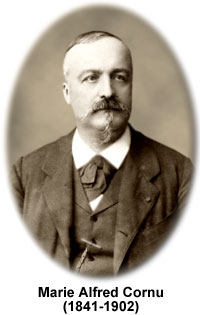Marie Alfred Cornu
(1841-1902)

Marie Alfred Cornu was born in Orleans France on March 6, 1841 and was educated at the École Polytechnique and the École des Mines. He became employed as a physics professor at the École Polytechnique in 1867, a position he maintained for the rest of his life. Cornu made a wide variety of contributions to the fields of optics and spectroscopy, but is most noted for significantly increasing the accuracy of contemporary calculations of the speed of light.
In 1878, Cornu made adjustments to an earlier method of measuring the velocity of light developed by Armand Fizeau in the 1840s. The changes and improved equipment resulted in the most accurate measurement taken up to that time, 299, 990 km per second. For the achievement he was awarded membership into the French Academy of Sciences, along with the prix Lacaze and the Rumford Medal of the Royal Society of England.
Other significant accomplishments of Cornu include a photographic study of ultraviolet radiation and the establishment of a graphical approach, known as the Cornu spiral, for calculating light intensities in Fresnel diffraction. A proponent of the wave theory of light, Cornu was also interested in the relationship between electricity and optics and the understanding of weather phenomena. He played a considerable part in the creation of the Observatory of Nice and in 1886 became associated with the Office of Longitudes. He received several honors during his lifetime, including an honorary doctorate from Cambridge University awarded three years before his death in April of 1902.
Measuring the Speed of Light - Starting with Ole Roemer's 1676 breakthrough endeavors, the speed of light has been measured at least 163 times by more than 100 investigators utilizing a wide variety of different techniques. Finally in 1983, more than 300 years after the first serious measurement attempt, the speed of light was defined as being 299,792.458 kilometers per second by the Seventeenth General Congress on Weights and Measures. Thus, the meter is defined as the distance light travels through a vacuum during a time interval of 1/299,792,458 seconds. In general, however, (even in many scientific calculations) the speed of light is rounded to 300,000 kilometers (or 186,000 miles) per second.
